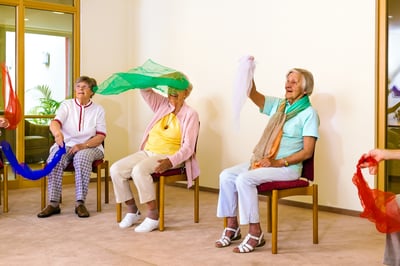 While we've seen significant progress in what exercise can look like for residents in independent living (IL), for many communities, there remains something of a disconnect in making sure residents throughout the continuum of care have access to the same or similarly robust services and amenities. The IL residents at a community often have a fitness center, pool, robust group fitness calendar, and individualized services available to them and in many cases as they transition to AL or other areas of care on campus the drastic decline in available options shifts them from a professionally managed health and fitness program to chair-based exercise classes lead by an activities professional. This is not an equitable approach.
While we've seen significant progress in what exercise can look like for residents in independent living (IL), for many communities, there remains something of a disconnect in making sure residents throughout the continuum of care have access to the same or similarly robust services and amenities. The IL residents at a community often have a fitness center, pool, robust group fitness calendar, and individualized services available to them and in many cases as they transition to AL or other areas of care on campus the drastic decline in available options shifts them from a professionally managed health and fitness program to chair-based exercise classes lead by an activities professional. This is not an equitable approach.
[Read More: 3 must-have services in your senior living community fitness center]
For our clients though, this hasn't been the case because our staff are pushing on the leading edge of what expanded fitness programming for residents in assisted living (AL), and memory-care environments can look like. If you’re ready to take a closer look at the exercise program you provide for residents in licensed areas, these three questions are a great place to start:
How do you answer questions about options for exercise in higher levels of care?
Whether you work in a standalone AL or memory-care community or in a Life Plan (CCRC) environment, prospects and families inevitably ask about the physical activity options that are available beyond billable rehab services. They understand the importance of keeping the mind and body in motion as part of a daily lifestyle. Does your community have a good answer for these questions that demonstrates robust options that are purposeful and executed by trained staff specially for residents who need a higher level of care?
How do you support residents after they finish therapy?
In licensed areas, residents often have rehab services readily available to them and that might seem like an easy "exercise" solution. However, billable therapy has limits. How do you support residents when they are discharged after 6-8 weeks of therapy and eliminate the revolving door of improved function leading to a discharge from therapy services followed by a decline due to lack of physical activity options which leads them back in therapy again?
How do you facilitate resident moves to higher levels of care in a way that provides them with consistent access to exercise options?
If you operate a Life Plan community with a robust fitness program for your IL residents, how do the residents’ options compare in terms of amenities, programs and services, and qualified staffing as residents move through the continuum? Having a continuation of offerings can be a great comfort as residents transition from one part of the community to another and it’s a valuable demonstration that the lifestyle they buy into in IL truly carries with them with whatever level of care they might need on campus.
Your answers to those questions may leave you with program and service gaps to fill. In our 12+ years working in senior living, we’ve developed best practices in exercise with residents in assisted living and memory care for:
- Group fitness class offerings beyond basic chair exercise classes taught by the activities staff
- Individualized services including personal training and fitness and balance assessments
- Dedicated exercise equipment and spaces
- Enriching wellness-based programming opportunities
Want to learn more about how you can build more comprehensive exercise services for your residents?

